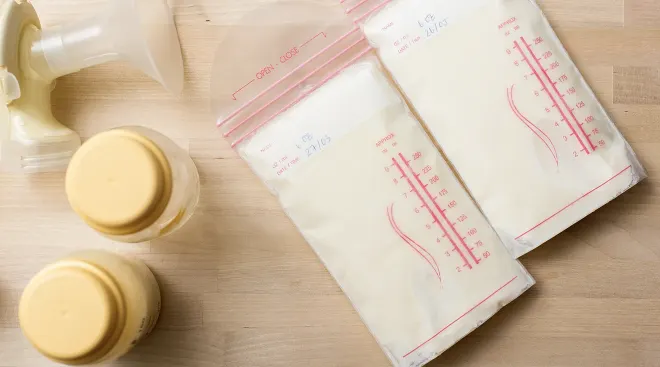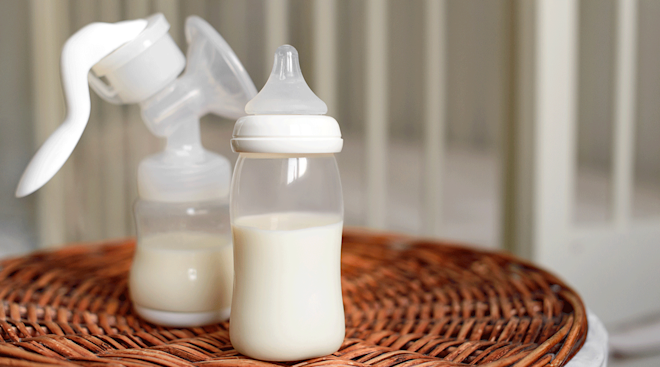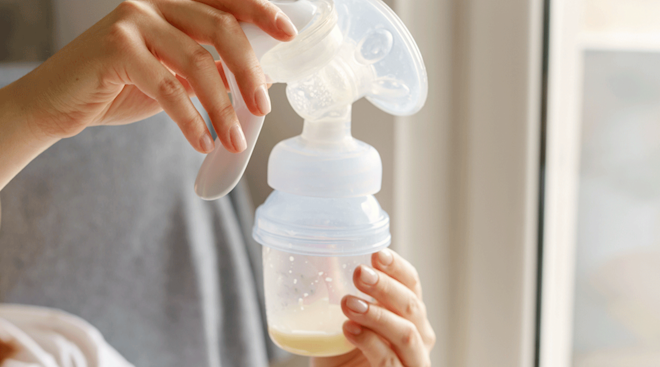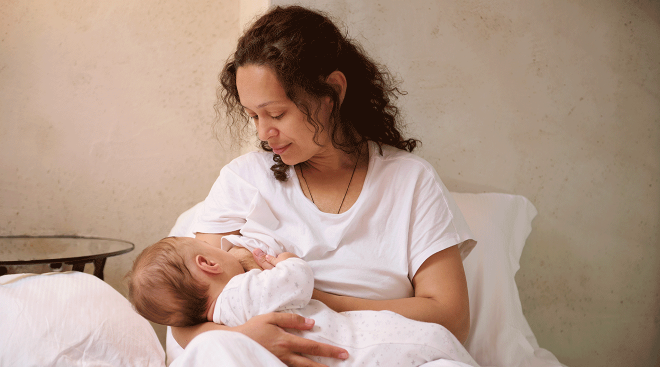Breastfeeding 101: How to Breastfeed Baby
When my daughter was born, just past midnight on a snowy Saturday, I was elated. But as the hospital room bustled with doctors, nurses and family, I didn’t get to hold her properly until nearly an hour later. I didn’t nurse her ’til even later than that. By then, the world had gone to sleep and it was just the two of us, curled cozy in the bed. Luckily, she was a natural at breastfeeding—but for me, the learning curve was steeper.
These days, most moms-to-be know the drill: Doctors suggest nursing baby within minutes of birth, using immediate skin-to-skin contact to better bond with your child. The American Academy of Pediatrics recommends breastfeeding exclusively for the first six months of baby’s life, then introducing solids as a supplement while continuing to breastfeed for the first year and beyond. But when it comes time to actually start nursing, many new moms struggle in the beginning. After all, learning how to breastfeed is an entirely new endeavor for both you and baby, and getting accustomed to it can take some time and patience. Whether you’re anticipating baby’s arrival or have already welcomed your newborn, learning the breastfeeding basics—from the proper breastfeeding latch to the best breastfeeding positions—can help the nursing process go more smoothly for you and baby, right from the get-go.
Learning how to breastfeed comfortably and effectively can take a little practice, but the act of nursing is fairly straightforward. Here, a step-by-step guide to how to breastfeed baby.
• Step 1: Look for baby’s hunger cues. According to the March of Dimes, when baby is hungry, she may root (aka turn her head toward anything that brushes against her mouth or cheek), put her hands to her mouth or make sucking sounds. Ideally, you want to breastfeed baby before she starts to cry.
• Step 2: Get baby into a breastfeeding position. Bring baby close to you in whatever breastfeeding position is most comfortable for the both of you (see Best Breastfeeding Positions.) You can also use a breastfeeding pillow for support.
• Step 3: Entice baby to nurse. Get baby to open wide by rubbing his cheek or gently pushing your nipple against baby’s upper lip. You can even express a bit of breast milk and rub it onto your nipple—the smell of milk will help entice baby to nurse.
• Step 4: Encourage a good latch. To make sure baby gets a proper breastfeeding latch, hold your fingers in a V shape around (but not touching) your areola. You want baby’s lower lip to be well below the nipple so she gets a large mouthful of breast. A deep latch will help make sure your nipple is at baby’s soft palate at the back of her mouth instead of her hard palate toward the front, which can cause discomfort.
So how to do go about finding the best breastfeeding position? And how can help baby get a proper breastfeeding latch? Read on for answers.
Most new moms have heard that helping baby establishing a solid, secure latch is critical when it comes to learning how to breastfeed. But what does that mean, exactly? The breastfeeding latch is the moment when baby takes your nipple and areola into her mouth and “latches” on. How she goes about doing that is important to ensuring she gets enough milk—and doesn’t cause you pain in the process. Here’s how to perfect the proper breastfeeding latch, and what to do when baby’s latch needs a little work.
Nailing a proper breastfeeding latch
There are two main things to look for when beginning a feeding: the depth of the latch, and the position of baby’s mouth.
• Depth. “A deep breastfeeding latch is key here,” says Wendy Wisner, IBCLC, a certified lactation consultant in New York City. “Generally, you want a wide mouth, with baby taking in as much of the breast tissue as possible. A baby sucking on just the end of the nipple hurts a whole lot!”
• Lip position. To get a good breastfeeding latch, it’s also important to note the shape baby’s mouth forms around the nipple, because it affects baby’s ability to suck. “The lower lip—which is very difficult to see—may be curled inwards instead of outwards,” says Susan Crowe, MD, clinical associate professor of obstetrics and gynecology at Stanford University School of Medicine. “If that’s the case, gently pull down on the skin below the lip, and the lip will naturally flange outward.”
As you’re figuring out how to breastfeed, getting the proper breastfeeding latch can take some work. But once you know the breastfeeding basics, it should be comfortable and pain-free.
Breastfeeding latching tips
So now you know what a proper breastfeeding latch looks like—but how can you make sure baby’s doing it right? Here, some of our top breastfeeding latching tips:
• Go tummy to tummy. Start by elevating baby’s body so she’s tummy-to-tummy with yours. “Keep baby’s body close to you for a good breastfeeding latch,” says Tamara Hawkins, an IBCLC-certified lactation consultant and founder of Stork & Cradle, a breastfeeding support service in New York City. “If possible, you want baby to be a little below your breast when latching on, with his head tilted a little back. That helps baby latch on with a wide, open mouth.”
• Get baby to open wide. To encourage a solid breastfeeding latch, “tease baby’s mouth open by pushing the nipple against baby’s upper lip so baby roots or lifts her head up and back to open up really wide,” Hawkins says. “When the tongue is down and the mouth is open, bring baby up to the breast. Ensure that her cheeks and chin are pushed into the breast, but her nose may or may not be touching it.”
• Offer all of your areola. At least a half inch of your breast (in addition to the nipple) should be in baby’s mouth for a proper breastfeeding latch.
• Pay attention to posture. Keep your back straight and bring baby to your breast. It’s important to pull baby close to you to nail that breastfeeding latch.
• Listen for little gulps. Watch baby’s cheekbones and keep an ear out for swallowing sounds to make sure baby is really drinking. Don’t be fooled by just suckling sounds—they don’t always mean baby is actually getting milk.
What to do about a painful latch
In simple terms: A painful breastfeeding latch means there’s a problem. “For new moms, there may be some discomfort in the beginning, upon latching” Crowe says. “But the pain should not continue throughout the feeding. If you’re feeling pain after the first few minutes of breastfeeding, that’s a signal that something isn’t right.”
So what could the problem be? Sometimes baby understands how to breastfeed properly right off the bat, but the wear and tear of nursing can cause nipple and breast tissue issues that cause mom pain. Here, some common problems and how to deal:
• Cracked nipples. “If the injury to the nipples is superficial, sometimes expressing a bit of breast milk—which has antimicrobial factors in it—can help,” Crowe says. “Letting that breast milk dry onto the nipple can help promote healing.”
• Inverted nipples. If you’re running into a problem because of inverted or flat nipples, it’s important to get familiar with your anatomy. “My first step is to have mom simply roll the nipple (with freshly washed hands) to see if the nipple will revert,” Hawkins says. If the inversion continues, using a nipple shield to protect the breast can make nursing easier, but may also cause a reduction in milk supply.
• Flat nipples. When it comes to flat nipples, Hawkins says, it’s important to ensure that you’re not suffering from swollen breasts due to fluid retention in the breast tissue itself. To relieve the swelling, she suggests what’s called reverse pressure softening, a procedure in which you massage the breasts around the areola to educe the inflammation.
• Clogged milk duct. Clogged milk ducts occur when the milk gets backed up in your ducts, preventing the milk from flowing out of the nipple. It can be caused by poor latching, delayed milk removal, pressure on your breast from restrictive clothing (yes, that bra could be the culprit), or even a weak pump. Lots of rest, hot compresses and sustained, frequent nursing can help resolve the issue, which may spiral into mastitis if left untreated.
• Mastitis. Mastitis is a condition in which breast tissue becomes tender and inflamed, causing pain and irritation, flu-like symptoms and fever. It should be addressed by a doctor.
“The thing I can’t stress enough is that if mom is in pain, there’s no reason to wait. Get help,” Crowe says. “A lot of times women come in and they’ve been suffering for a while. But getting help early means they can prevent severe damage and ensure that baby is getting the breast milk he needs.”
Part of learning how to breastfeed is figuring out which best breastfeeding positions that work for you and baby. There’s no one specific position that’s ideal for everyone, but generally “the best positions are ones where baby is belly to belly with mom,” says Wendy Wisner, IBCLC, a certified lactation consultant in New York City. “You want baby as close as possible to you so the breast won’t drag in baby’s mouth.” Some moms of newborns find that they prefer the “cross-cradle” or “football hold,” while others get into the groove with the more relaxed laid-back breastfeeding position. Not sure what these positions look like or how to do them? Read on.
• Cradle hold. Drape baby across your lap, tummy to tummy, using the arm on the side of the breast baby’s feeding from to support baby’s head and body.
• Cross-cradle hold. Drape baby across your lap, tummy to tummy, using the opposite to the breast baby’s feeding from to support baby’s head and body.
• Football hold. Also called the “clutch hold,” in this position mom tucks baby under her arm to the side of her body (not unlike a football), while mom supports the breast with the other hand. Intuitive and familiar, this is one of the first feeding positions new moms use.
• Laid-back position. We get it—sometimes you’re just tired. Nursing baby while lying down can be a relief. The laid-back hold allows mom to recline at a 45-degree angle with baby’s body draped across her own to nurse. Before you breastfeed in laid-back position, there are a few safety guidelines to keep in mind, Hawkins says: You have to have a healthy, full-term infant. The bed should be free of clutter, distractions or dangers, including other people, pets and blankets. And last but hardly least, it can be dangerous to fall asleep in bed (or even in a chair) with your newborn.
• Side-lying position. For this in-bed breastfeeding position, lie down on your side with baby facing you. Baby nurses from the breast that’s resting on the bed.
• Upright position. In this position, have baby sit upright, facing you and straddling your knee. You’ll support baby with the arm on the same side as baby is feeding and support your breast with the opposite hand, like in the football hold.
How to breastfeed twins
Most moms find it hard enough to establish a comfortable breastfeeding routine with one baby, so learning how to breastfeed twins can be an even bigger challenge. There are two breastfeeding positions that can work well for nursing twins:
• Double-cradle position. Each baby lies in the crook of each elbow, crisscrossing each other in your lap.
• Double-football hold. With this hold, your babies’ bodies rest of pillows along your sides and under your arms.
But keep in mind that tandem breastfeeding can be difficult and stressful, especially in the beginning. Instead, “treat each baby individually,” Hawkins suggests. “They will each have different needs and will breastfeed differently.”
Not only do moms of twins need to balance each child’s need, they also need to account for milk imbalances. “One breast will typically have more milk than the other,” Hawkins says. One way to even things out: “Breastfeed Baby A on the left breast and Baby B on the right breast for a day, then switch them to the opposite breast the next day,” she says. Another option? Switch breasts for each baby at every feeding—although you’ll need to take careful notes to remember which baby got which breast.
At the end of the day, don’t beat yourself up if you need to supplement with bottles. “Sometimes moms need to breastfeed one baby on each breast per feeding and give the other baby a bottle of breast milk or formula,” she says. And that’s okay. “It’s best to get a lactation consultant to work out these options to see which one will best fit your family needs.”
How to breastfeed in public
Some new moms are super-comfortable breastfeeding in public, while others might be a bit more bashful. Know this: Legally, it’s your right to feed baby in public. In fact, 49 states have laws specifically guaranteeing your right to breastfeed in any public or private space.
To make yourself more comfortable nursing baby in public, Hawkins suggests a bit of preparation. “Wear two layers: a tank top or a cami under a t-shirt and over a bra,” she says. “Bring baby to your body in a cross-cradle position, put your hand underneath your T-shirt, pull down the tank, unlatch the bra and bring baby to feed. That way, you’re minimally exposed.” You can also use a nursing cover for more privacy, but Hawkins warns they may not be comfortable in warmer weather. Plus, as baby gets older, he might got frustrated with a cover and try to remove it.
Many new moms think that if baby’s not on a schedule, they’re doing something wrong. But especially with a newborn, there’s no such thing as a breastfeeding schedule. “Feed a newborn as often as they want to eat. If he’s hungry, feed him,” Crowe says. Rest assured, as long as baby is eating, pooping and growing, she’s doing okay—and so are you. “Women often think that they don’t have enough milk, and occasionally, someone won’t,” Crowe says. “But by and large, they do have enough milk if they’re feeding on baby’s cues.”
How often to breastfeed a newborn
When it comes to breastfeeding a newborn, you can expect anywhere from 12 or more feedings a day—which sounds intimidating but is perfectly normal. “This is the period where you’re establishing milk supply, so they need to feed frequently in order to do that,” Crowe says.
So how long does it take to breastfeed? “You can’t really put a time on it,” Crowe says. Generally, nursing sessions can last a few minutes or run up to an hour, although newborn feedings will often take longer. After all, you’re both learning. “As baby and mom learn how to work together, baby will become more efficient in feedings,” Crowe says. Instead of watching the clock, keep an eye on baby’s cues. “As long as baby is eating and gaining weight, you’re doing okay,” she says.
How long to breastfeed on each breast?
Allowing your child to nurse fully on each breast is critical, because baby needs access to the hindmilk that comes later in the feeding. “Hindmilk has a higher fat content and will keep baby satiated for a longer period of time,” Crowe says. “It also gives baby the special kind of fat that she needs in order to grow.”
As for how long to breastfeed on each breast, every baby—and every feeding—can be different. Some babies might spend 10 minutes on each breast, while others might spend 30 minutes. As baby grows, the timeline can change too. Tools like The Bump breastfeeding log can help you track baby’s feeding schedule and intake. But cut yourself some slack. “Try not to get caught up in a schedule until baby is steadily gaining an ounce per day,” Hawkins says. Eager to learn more about how much a newborn should eat? Head here for an age-by-age feeding guide.
And perhaps most importantly, if you need help, don’t be afraid or embarrassed to ask for it. Wisner suggests starting with free and low-cost resources, like La Leche League, which can offer guidance, materials and support groups that connect you with other new moms. Beyond that, she says, you can reach out to a private lactation consultant who can come to your home and show you how to breastfeed, how to establish the proper breastfeeding latch and offer solutions to any breastfeeding problems you encounter.
Updated August 2017
Plus more from The Bump, 5 Things To Know Before You Start Breastfeeding:
Please note: The Bump and the materials and information it contains are not intended to, and do not constitute, medical or other health advice or diagnosis and should not be used as such. You should always consult with a qualified physician or health professional about your specific circumstances.
Navigate forward to interact with the calendar and select a date. Press the question mark key to get the keyboard shortcuts for changing dates.




















































